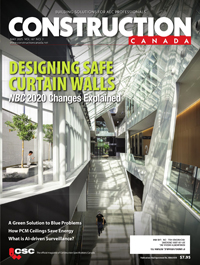Assignment of design to constructors: Documentation and drawings
Specification contents

MasterFormat includes classifications covering the need for submittals during construction and provides a location for describing deferred design procedures within Division 01–General Requirements. These sections must include definitions and identify content appropriate to local practices associated with deferred, delegated, and assigned design and design-assist. They are applicable to all divisions within MasterFormat and to all RPRs, regardless of discipline, following the principle of, “Say it right in one location, and reference from all other locations within the document structure.”
A complete listing of deferred design components necessary for the project must be included in the specification, describing deferred design procedures, making project requirements explicit to the constructor, and clearly identifying and incorporating costs associated with the design solutions in bids for the project.
The authors note their own firm is not consistent in the way it currently describes deferred design. The firm has occasionally used implicit language describing requirements surrounding deferred design components, which does not state in complete, reliable, and identifiable terms the degree of responsibility being attributed to the constructor’s design solutions.
Technical specifications
Specification sections can make identification of the different types of submittals required to administer the deferred design process more explicit to the constructor by referencing the document preparation guidelines publication, CSC/CSI SectionFormat/PageFormat. This includes the following types of submittals, which must be provided before any onsite work starts.
- Action submittals
Submittals indicating the constructor’s design solutions for constructability and conformity with the RPR’s engineering, which can include submissions such as letters of commitment and compliance, shop drawings, product data, samples, and other information requiring review and acceptance by the RPR.
- Informational submittals
Submittals necessary for co-ordination of the work associated with assigned design or for proof of performance where review from the consultant is limited to assessing items are in general conformance with stated performance requirements. This can include shop drawings (with limitations), certificates, testing reports, source and site quality control submittals, and qualification statements.
- Sustainable design submittals
A third potential submittal type forming a part of the deferred design process can be associated with special project procedures, such as documentation providing confirmation of sustainable design-related components. Part of project recordkeeping, these documents are usually submitted concurrently with informational submittals.

Individual technical specification sections must contain clear submittal requirements indicating which submittal type or combination of submittal types is required during the contract administration phase of the project. The specification must also contain accurate descriptions of the engineering, esthetic, and performance criteria on which the constructor will base the design solution, including co-ordination of related requirements and cross-discipline communication.
Drawing content
Drawings are the best place to identify and co-ordinate deferred design content. This content must be explicit and should be located on the drawing set with the most impact on the design deliverables. For example, architecturally exposed structural concrete or structural steel is best identified on the structural drawing set, while the exposed layout of mechanical ductwork is best identified and fully illustrated on the mechanical drawing set. In these examples, the architect is usually the CPR, meaning content for deferred design components is fully identified on the architectural drawing set with references to the appropriate sheet locations and detail numbers.
Simply stating ‘see structural’ (or mechanical, electrical, etc.) is not acceptable, since this misses the requirement for providing explicit direction to the constructor for design responsibility. Under no circumstances should a deferred design component be identified on the drawing sets that has not been directed by the RPR, to prevent inadvertently transferring engineering responsibility to the constructor.
Deferred design content must be directed and reviewed by each contributing RPR and harmonized between each discipline so complete content is available in one fully co-ordinated drawing location with clear indication to the constructor of loads, restrictions, geometry, and other design-dependent information the supporting registered professional or supporting certified/qualified contributor will need to complete design solutions.







